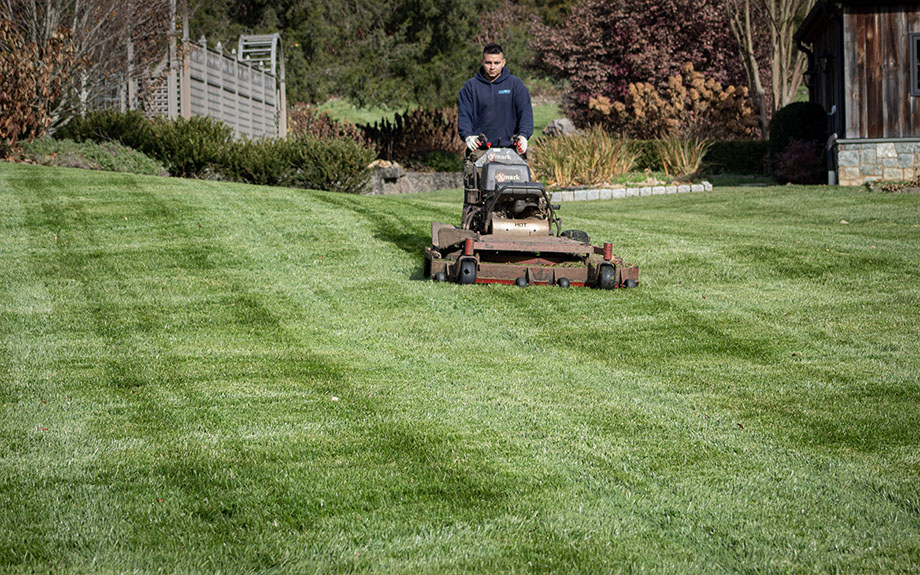Blog Topics
Are you making any of the common mowing mistakes that can harm your lawn?
Even if you’ve been mowing lawns for years, you may still have room for improvement. And if your lawn has never reached the level of emerald perfection you’d like, a few technique changes may get you over the top.
To help you turn your lawn into the green carpet of your dreams, we share the mowing practices to avoid, explain how these mowing mistakes harm your turf grass, and describe what to do instead.
Lawn Mowing Mistakes to Avoid
Mowing Too Often
Most people mow their lawn every weekend (after all, that’s when you have “free” time, right?). But the frequency should really be based on how quickly the grass is growing – and that varies with the weather (for example, high heat and dry weather slow growth down), conditions (rain means a delay in mowing), turf type, overall health of the lawn, and more.
Leaving your lawn grass to grow a little taller also has several benefits:
- Taller grass can smother weeds more easily, by shading them or out-competing them.
- Taller grasses have more surface area for photosynthesizing, meaning healthier, stronger blades.
- Longer grass blades reduce water evaporation, so your irrigation water goes further.
- Keeping your mower set higher reduces the chance of over-mowing, or “scalping” areas of grass

Not Mowing Often Enough
This is not to suggest that you don’t mow regularly while your lawn grows in the warm months. Mowing so that you only need to take off a third or less of the height of your grass is a good rule to follow, as it keeps your grass blades at a healthy height and makes mowing easier.
Over mowing to compensate for a shaggy lawn means too-short grass and excessive clippings. While we normally recommend leaving grass clippings on the lawn to provide nutrients to the turf as they decompose, you shouldn’t do that if mowing has left large clumps or a thick layer. Excessive mulch clippings left on a lawn can block sunlight from reaching the grass beneath it, creating yellow areas that tempt people into using too much fertilizer to compensate.
Cutting Grass Too Short
Over mowing, or cutting grass too short, causes turf to dry out faster and can make bald spots where too much of the grass has been sheared off. Open areas in lawns are ideal for weeds to establish themselves, and seeding to fill in empty areas means you’ll have to stay off your grass (right when you want to lounge on it) until it grows in.

Mowing Wet Grass
Don’t mow if your lawn is wet from dew, rain, or irrigation.
- Wet grass blades are heavier and will bend or fold flat in front of your mower. This means you won’t get an even, overall trim, and areas of taller grass will spring up once the grass dries.
- It’s also more likely that your mower will tear grass blades instead of neatly clipping them, resulting in more visible damage to the ends of grass blade.
- If you mulch grass clippings over your lawn, they won’t be evenly distributed, and heavy clumps of wet grass can encourage fungus growth beneath them.
A dry lawn (and a sharp mower blade) ensures the evenest cut and an even distribution of mulched clippings.
Mowing With Dull Mower Blades
Keep your mower blades sharp. Just like in the kitchen, a sharp blade does a better job and saves time.
- Cutting your lawn with a dull mower tears, shreds, or pulls grass blades instead of neatly cutting them. This results in larger, irregular areas of grass blade damage, and missed spots you have to re-mow.
- If you see a white or brown cast to your lawn surface, it may be grass blade damage from a dull mower blade.
Regular mower blade sharpening is part of general tool maintenance that includes cleaning and oiling to keep your mower running efficiently. It also saves you time (no need to do a double-pass when mowing) and money (because your mower will last longer).
And don’t forget to clean your mower before winter storage. You’ll start your spring lawn care with a fine-tuned machine instead of visiting a repair shop or spending a sunny afternoon yelling at your tools.
Always Mowing In The Same Direction
You may have a habit of mowing your lawn the same way each time. If so, you might want to head in a new direction. Changing the direction of your mower is good for your grass for several reasons:
- You’ll avoid making ruts. Running your mower over the same place repeatedly will encourage ruts and reinforce irregular slopes in your soil’s surface. You’ll reduce repeated wear on the same grass from mower wheels, too.
- You’ll increase airflow. Shifting the location of your mower means you won’t compact the same strips of lawn, so you reduce soil compaction. Compacted soil repels water and reduces root growth, which you don’t want.
- You won’t flatten your grass as much. Cutting grass blades in the same direction can increase their tendency to grow in one direction. Regular direction changes will help keep grass blades upright, making your lawn look neat and even.
- You’ll look like a pro. Those stripes on baseball fields not only look neat, but they’re also beneficial. If you have enough lawn, you can mow stripes, checkerboards, or plaids in your lawn, too.
Alas, small lawns cut with a push mower won’t get the chance to be as flashy with patterning, but the grass will get the same benefits.
Don’t Want To Do All That Mowing Yourself?
We offer lawn maintenance programs to keep your lawn looking its best throughout the growing season. So, if you’ve had enough of mowing your lawn (or want to avoid any mowing mistakes), just give us a call at 703-402-9366!

Give Us a Call at 703-402-9366
If you'd like help with your trees or landscape, have any questions, or would like to schedule an appointment with one of our Certified Arborists, please give us a call. We'd love to hear from you!



